#kerala traditional dress
Explore tagged Tumblr posts
Text
Are you interested in knowing about Kerala History?
According to mythology, Parashurama threw his halberd into the sea. Due to this, a land of that size came out of the sea, and Kerala came into the entity. Proof of humans has been found here to the 10th century BC. To read in detail Kerala history and know about its facts read our blog.
#kerala traditional dress#kerala festival#kerala history#wildlife sanctuary in kerala#famous festival of kerala#kerala economy#kerala wildlife#kerala geography#tourist places in kerala
1 note
·
View note
Text





𝐒𝐡𝐢𝐯𝐚𝐝𝐚 𝐥𝐨𝐨𝐤𝐬 𝐝𝐢𝐯𝐢𝐧𝐞 𝐢𝐧 𝐡𝐞𝐫 𝐊𝐞𝐫𝐚𝐥𝐚 𝐏𝐢𝐫𝐚𝐯𝐢 𝐥𝐨𝐨𝐤, 𝐜𝐚𝐩𝐭𝐮𝐫𝐢𝐧𝐠 𝐭𝐡𝐞 𝐞𝐬𝐬𝐞𝐧𝐜𝐞 𝐨𝐟 𝐭𝐫𝐚𝐝𝐢𝐭𝐢𝐨𝐧.
Actress Shivada beautifully embraces Kerala’s essence in her Kerala Piravi special look. Draped in a classic traditional outfit, she radiates elegance and charm, paying homage to the rich cultural heritage of Kerala. Her outfit captures the spirit of Kerala Piravi, blending elegance with Kerala’s timeless traditions. Celebrate Kerala’s culture and history with Shivada’s divine Kerala Piravi look, a true representation of tradition and style. Don't miss out on this timeless celebration of Kerala!
Regards, Waves Institute of Fashion Designing
#kerala piravi#kerala culture#shivada#kerala style#traditional elegance#kerala dress#ootd#kerala actress#celebrity fashion#trendy fashion#kerala today#ethnic fashion#ethnic
0 notes
Text
Set saree online
When it comes to authentic Kerala pattu sarees, Haradhi stands out as the best Kerala saree brand in Palakkad. Known for its exquisite craftsmanship and dedication to tradition, Haradhi offers a stunning collection of Kerala traditional sarees that embody the rich cultural heritage of Kerala.
A Kerala pattu saree is more than just a piece of clothing; it's a symbol of elegance and tradition. Indeed, Haradhi's sarees are woven to perfection; the golden border serves as an identity marker for a sari from Kerala. Whether you're attending a wedding, a festival, or any special occasion, a Kerala traditional saree from Haradhi ensures that you make a statement with your attire.
What sets Haradhi apart is its commitment to quality. Each saree is crafted with the finest silk and embellished with intricate designs that reflect the timeless beauty of Kerala's textile tradition. If you're in Palakkad or looking to purchase a Kerala pattu saree online, Haradhi should be your go-to brand for an authentic and luxurious experience.
0 notes
Text
#vishu kidswear#vishu special dress for baby girls#kerala traditional dress for baby girl online shopping .
0 notes
Text
jackfruit chips 1kg price in Kerala
Discover the Delicious and Healthy Jackfruit Chips in Kerala

If you're a fan of healthy snacking, then you've probably heard of the delightful jackfruit chips. Kerala, known for its rich culture and delectable cuisine, is a paradise for food enthusiasts. The state is famous for its lip-smacking jackfruit chips that are not only delicious but also packed with nutrients.
The Irresistible Taste of Jackfruit Chips
Jackfruit chips are made from the raw fruit, which is sliced, deep-fried, and then seasoned with salt to create a crunchy and flavorsome snack. The chips are not only a treat for your taste buds but also offer numerous health benefits. They are rich in fiber, antioxidants, and vitamin C, making them a healthier alternative to traditional potato chips.
The Culinary Delight of Kerala
Kerala's culinary heritage is renowned for its diverse flavors and unique delicacies, and jackfruit chips are a true embodiment of this rich tradition. Whether you're a local resident or a visitor to "God's Own Country," trying out the local jackfruit chips is a must-do experience.
Conclusion
In conclusion, jackfruit chips are not just a delicious snack but also a healthy alternative to traditional chips. Their availability in Kerala offers both residents and tourists the opportunity to indulge in a flavorful and nutritious treat. So, the next time you're in Kerala, make sure to savor the delightful taste of jackfruit chips and experience the essence of this beautiful state through its culinary offerings.
Explore our online platform for supplementary details, https://bhakshanangal.com/#/home
#snack cake#jackfruit#traditional snacks of kerala#kerala snacks online#kerala famous snacks#evening snacks kerala#100 days of productivity#yogurt#cream cheese#baking#packaging#prose#poem#healthy snack#nutrition#pizza#cursive#odd numbers#evening dress#day6 even of day
0 notes
Text
Traditional Dress of Kerala: Elegance Woven in Culture
Kerala, often referred to as “God’s Own Country,” is a state in India that boasts a rich cultural heritage. One of the most captivating aspects of Kerala’s culture is its traditional attire. The traditional dress of Kerala is a vivid reflection of the state’s history, climate, and social values. In this article, we will delve into the captivating world of Kerala’s traditional clothing, exploring…
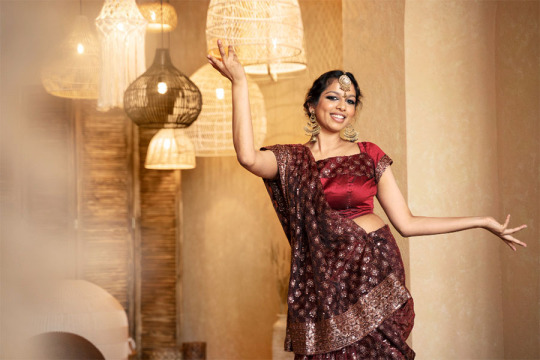
View On WordPress
#Kasavu Saree#Kerala&039;s traditional dress#Mundu#Neriyathu#traditional clothing in Kerala#traditional dress
0 notes
Text
Alright, I'm going down a rabbit hole.
In my Marioverse, there's a sort of universal way monarchies are run and how rulers are dressed based largely on historical Western Europe; most monarchies that adhere to this practice are allies, and thus it's sort of a symbol of unity, a distinct style that they all share in. However, each kingdom has its own parallel to nations in our world. The nations themselves reflect a mix of modernity and history, while monarchs wear their nation's traditional clothing for special occasions.
It's still heavily a work in progress, but here's what I've got so far!
The Sarasaland Empire is parallel to India. Its capital, while borrowing elements of ancient Egyptian culture and archeology, is actually parallel to the state of Rajasthan, while Daisy herself hails from the Muda Kingdom, which here is parallel to the state of Kerala. Daisy is thusly Marayali.
Since I can't draw, I'm scouring the internet for references for her traditional dress, and here's some good ones that sum up the idea: a traditional Kerala saree with an orange blouse and yellow/gold accents (first pic) and emerald jewelry (second pic).


For the Beanbean Kingdom, I'm thinking Southeast Asia? This one's had a lot less thought put into it. I jumped and said Laos first off, but now I'm thinking Cambodia. Complete coincidence and something I'm still researching, but Cambodia was colonized by France at one point in its history and a little over a million people still speak it, which would explain the presence of French within the kingdom. On top of that, its numerous famous depictions of the Buddha bring to mind the ever-present symbols of laughter the kingdom's themed after.

There is… frustratingly little in-depth info on traditional Khmer fashion in the English language, at least from cursory digging, so Peasley’s and Queen Bean’s traditional dress will take me a while longer to solidify. For now I’ve got lots more research to do on sampot, but their outfits will likely resemble these (just… less intimate in their posing, since they’re. Y’know. Mother and son).



Aaaaaaaand that’s about what I’ve got. I don’t even know where to start with the Mushroom Kingdom and Peach, but that’s my next goal!
#I'm still figuring out how languages work#there's a universal common tongue a la star wars' basic#but I dunno if it's largely overtaken native tongues or if most people in the eight realms are just. inherently bilingual#leaning towards the first one with the original languages being mostly preserved in academic circles#peaches’ illustrious lore
22 notes
·
View notes
Text
Pavitr Prabhakar: The Design
Pavitr Prabhakar my beloved!
I love him. I absolutely love Pavitr and everything about him. And the best thing about him, other than his everything, is his design. So let's get to it!
PART 1: THE MASK
He was so cool and such a total sunshine but the most striking aspect was the immaculate design. Huge upgrade on his old model which was pretty much just a normal spider-suit with a white dhoti, which, not gonna lie, was just disappointing and underwhelming. But they went off on Pavitr's design in the movie and everyone's talking about it so let's also talk about it.
First of all,
LOOK AT MY BOY!!!
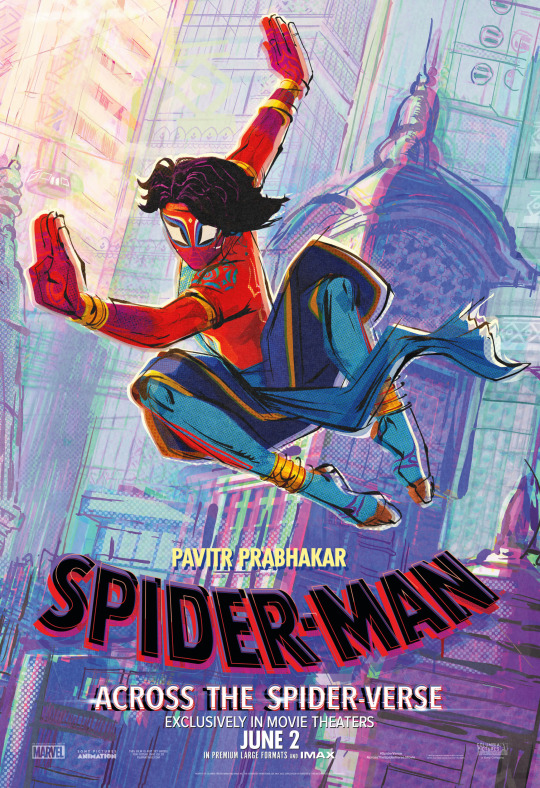
Just look at that design! So cool! So awesome! And so so Desi!!!
Its these desi aspects that I want to shed light on cos I know there are non-Indian fans who didn't catch a lot of the nuances cos they're not familiar enough with Indian culture and even Indian fans who didn't know about some details cos they aren't from the areas the inspiration for these elements were drawn from.
Mainly I hope to help artists and writers with this, so they have more information to create with, as well as the casual fans so they have more info and can immerse themselves better as well as appreciate just how much effort went into making this spectacular movie.
This might be a long post with me just rambling away so braze yourself people.
So lets get into it.
{WARNING: Infodump incoming}
First, lets start with the Mask
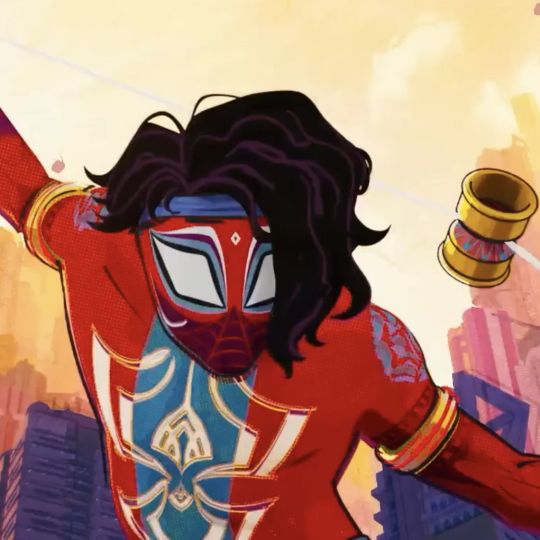
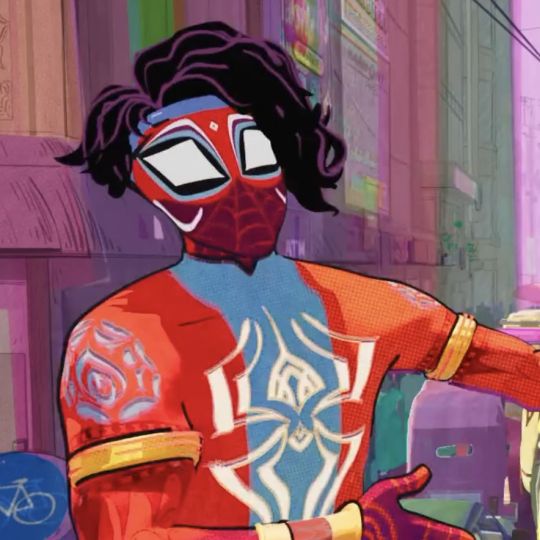
So here we have two different angles of his mask. The most prominent features of his mask are his eyes. There is a multi-layer outline for them in black, blue, red, and white, which of course are the classic spiderman colours but never quite used like this. Usually there is only a single outline in shades of, or adjacent colours of black, red, or white.
(Disclaimer: I'm not a 100% sure of this being actually the inspo behind the eyes. I'm pretty sure though, like 80%. So this has not been confirmed.)
The design for his eyes reminded me of one specific thing:
Koodiyattam, which is a 2000 year old ancient temple artform from the southern Indian state of Kerala. Koodiyattam is not just the only surviving Sanskrit theatre in the world, but it also includes elements of koothu, from the Sangam era, the golden age of Tamizh culture, and thus was declared by UNESCO as a Masterpiece of the Oral and Intangible Heritage of Humanity.
Below is a picture of a Koodiyattam performer.
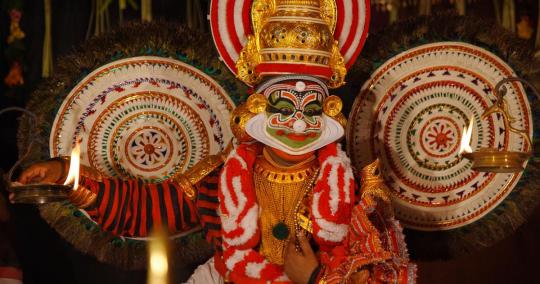
Instantly you'll realize that this is a costume drama, with extensive makeup, and complicated dress, especially with regards to the headgear, and is overall similar to the Beijing opera, not in terms of make or design or performance, but rather in elaborateness of ensemble. Japanese art forms like Noh or Kabuki could also come to mind along with certain Balinese dances.
Here is another photo which will give you a better look.
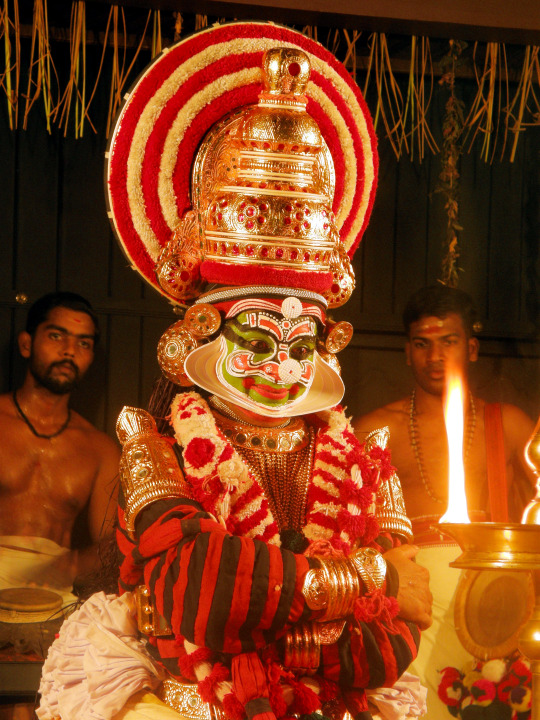
Notice the layered eye makeup in black, red, and white.
Here we have a closeup of a different performer where you can see it even more clearly.

The first time I saw Pavitr's eyes on screen, this is what immediately came to my mind as someone interested in traditional theaters of all kinds. Notice that Koodiyattam extensively uses reds and blacks, along with whites, which is also the colour palette that most spiderpeople choose, which is a cool coincidence. Blue is not that heavily used unlike the others however, but you can see it more in some costumes but generally not in makeup.
If we're talking less of what it reminded me of and more in terms of what the actual inspiration for the eye design probably was, it was most likely Kathakali, Koodiyattam's much younger, more well known, and very popular relative.
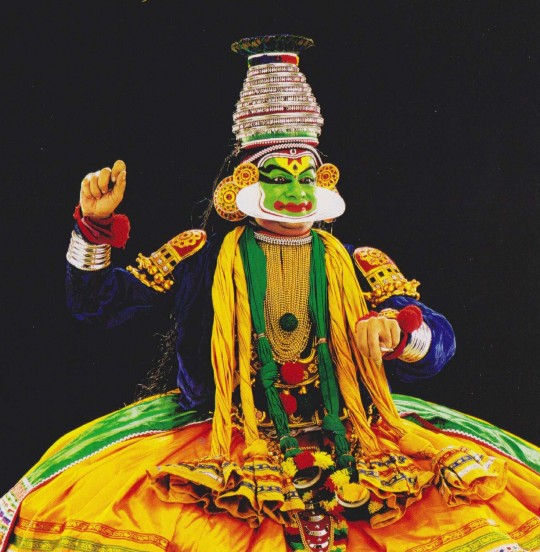
As you can see, Kathakali took its cues for costuming from Koodiyattam. (Actually it took its costuming cues from earlier art forms called Krishnattam, and Ramanattam, but they took it from Koodiyattam so it works.)
Again you can see the layered eye makeup, most prominently in black. (Cool fact, the costume and makeup changes according to the characters being portrayed on stage.)
Below is a picture of a Kathakali character with more elaborate eye makeup.
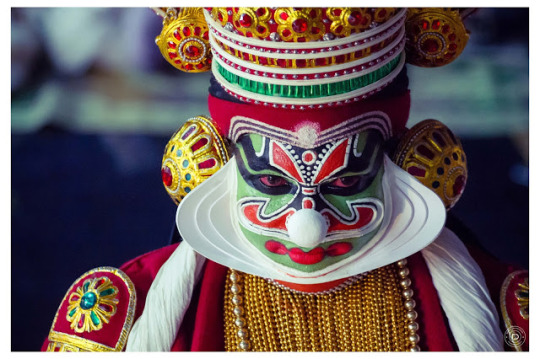
(I know a lot of you might think its the same makeup as Koodiyattam but I promise you its not. Inspired yes, same no.)
Because of the elaborate makeup and costume, expression can be a challenge so the art forms make maximum use of exaggerated body movements, hand signs, dance, lyrics etc. But the crowning element of acting in Koodiyattam and Kathakali are the eye techniques and how much simple eye movements can convey to the audience, which if you think about it, is also the case for spider-people. They're the most expressive superheroes in any medium, but they're fully covered so a lot of their expressiveness, both in comics and animation is conveyed through the shape of the eyes, body language, and speech. Another cool coincidence.
Below is a link to a short video which gives an brief overview of Kathakali and the importance of eyes in its performance.
youtube
This second link is a closeup of the eye movements of a female Kathakali character (women characters are called 'Minukku'). It shows how these highly trained artists can even move their eyes according to music. I have been told this can be uncomfortable to watch for some people so here's a warning for those who find eyeballs discomfiting.
youtube
And finally this one right here is a link to a short video on Koodiyattam.
youtube
{All three of these links are mainly aimed at people who find this sort of stuff interesting and want to check them out so if you're not, you can scroll past it, no big deal!}
(Oh man this is getting way too long and more like me gushing about traditional theatre than spiderman. Sorry about that.)
Now lets get back to our boy Pavitr. The second most noticeable feature of his mask is the curved, white line underneath his eyes, which gives off the impression of tusks. The first two pictures on this post already show the lines quite clearly but I'll attach one more angle.

Something that immediately came to mind when I saw them was Theyyam but I wasn't sure until I saw this post.
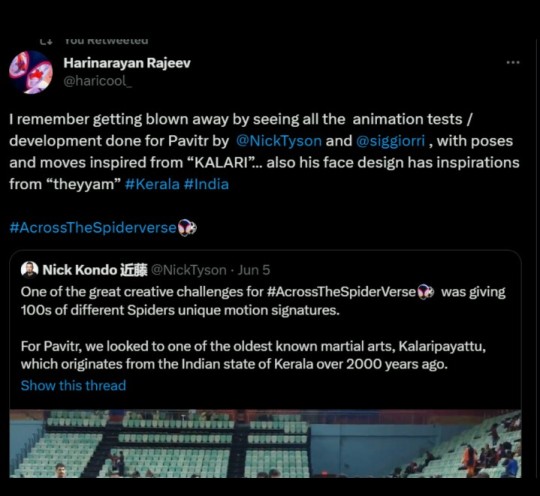
This was the same account that talked about how Pavitr's movements are inspired from Kalaripayattu so I was inclined to trust this. And after this one of the animators did confirm this so I was right on the money.
What exactly is Theyyam?
It is an ancient Hindu folk ritual practiced in northern Kerala, predominantly in the North Malabar region. Its origins can be traced back to the neolithic and chalcolithic eras. And unlike Koodiyattam and Kathakali which are associated with temples and the Koothambalam(temple theatre where temple artforms are performed), Theyyam is performed in the open air in Kaavu, the sacred groves of Kerala. The Theyyam performers become channels and vessels for the gods. Connect this to the 'Great Weaver'/ 'Master Weaver' who gave Pavitr his powers.
(Btw, these sacred groves are also ecological treasure troves and one of the ancient ways of nature preservation and they're really cool so check them out if you can.)
Below are two images of different Theyyams.
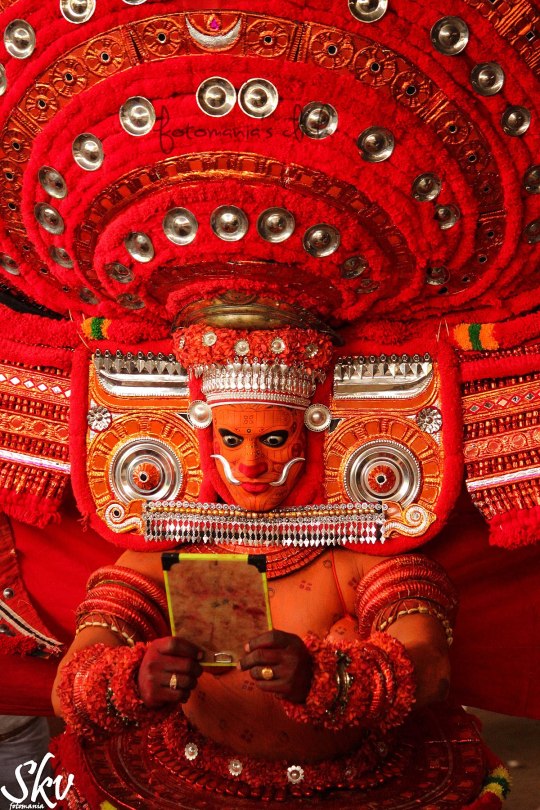
[Puliyoor Kali Theyyam]
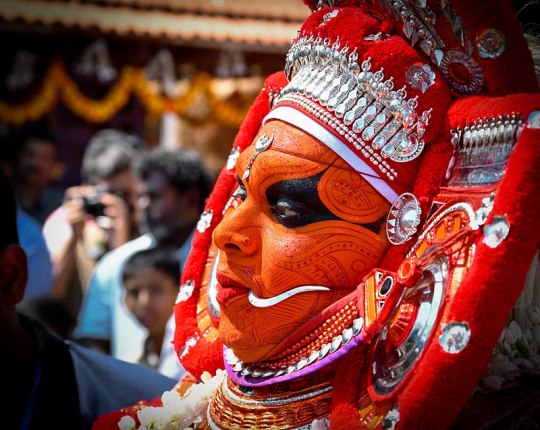
[Porrkali Theyyam]
See that on the cheeks? It resembles Pavitr's design closely right? While Pavitr's are drawn on his mask, these are singular metallic pieces, bound or clutched in the mouth to evoke the imagery and impression of tusks.
Theyyam is not alone in this particular imagery. A variety of folk arts use this, especially animism and folk rituals to show animal physical characteristics, as well as supernatural powers and elements.
For example, below is an image of Thirayttam, a ritual folk practice from the South Malabar region of Kerala. You can see the tusks here too. (Its not that clear, sorry about that.)

{Reminder: A lot of people think of Theyyam and Thirayattam as the same thing. While there are many similarities, with both being from the Malabar region, they are different practices. Theyyam is also called Tiṟa, and this is the main cause of the confusion but its not Thirayattam.}
Another example is Kalamezhuthu pattu, another religious folk art from Kerala. Mainly associated with the worship of the goddess Badhrakali, it is a sacred floor art done with powder and the result is called a Kalam. Below is a picture of a Kalam.
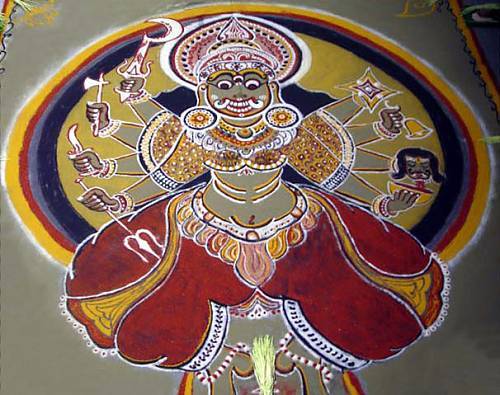
See those tusks? Yeah.
So they represent divinity, animal characteristics, inhuman powers etc.
[Interesting Info: Drawing Kalams are an integral part of Mudiyettu, a traditional ritual theatre and folk dance drama from Central Kerala. It is inscribed in the Representative List of the Intangible Cultural Heritage of Humanity. So do check it out if you're interested.]
{Oh my god I'm going off topic again. Come back bitch.}
To conclude, those lines are inspired by Theyyam markings, and stand for tusks and fangs, and as a spiderperson, who has the powers of a spider, gifted by some spiritual channel, its really apt that he was given such a design.
Next, lets talk about the lower half of Pavitr's mask.
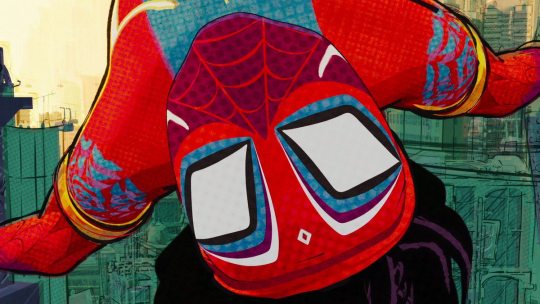
See those delicate red webs underneath the eyes?
This also reminded me of Theyyam. Its overshadowed by the more vibrant aspects of the costume, but a Theyyam's face has these intricate red patterns as well.
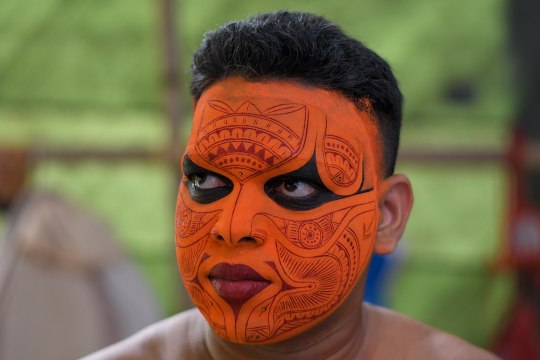
(Look at those eyes, reminds you of Pavitr's eye design right?)
And as you can see in this next image, after the headgear is put on, the designs mainly concentrate on the lower half of the face, much like Pavitr's mask.
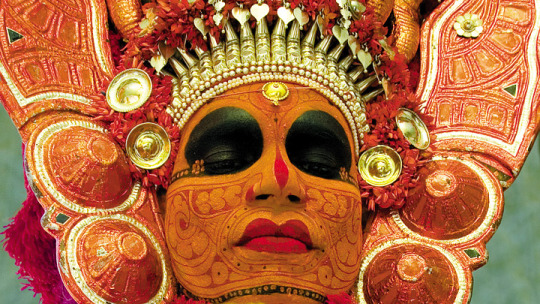
I admit I might be stretching this as web designs on the mask is a spiderman thing in general but I think I'm the pretty much on the dot on this one, and most likely its a combination of both.
[A 100% sure about that tusk thing though :)]
Also sometimes Theyyams would have these metallic eye coverings.
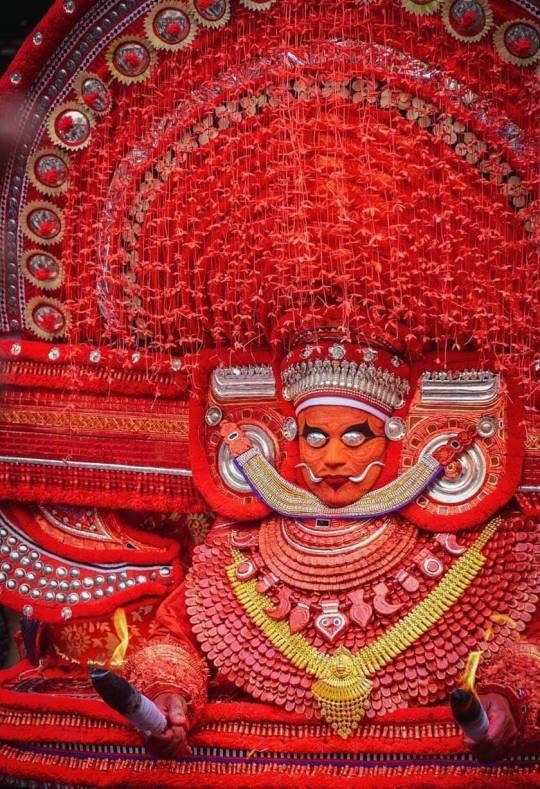
[Muchilot Baghavati Theyyam]
A closer look.
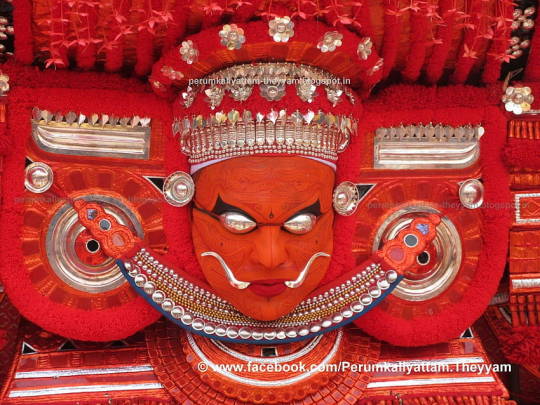
This is just my opinion but those silver eye masks kind of reminded me of the classic Spiderman eyes. Single colour, pupil-less, black outline, no idea how they see out of it etc. This one in particular reminded me of the classic spiderman especially with the eyes outlined in black like that.
Overall, the tusks, plus the thin web design on the mask, and the eyes, the spiderman red colour palette, they all evoked the image of Theyyam for me when I first saw Pavitr on screen.
{There is a very similar art form to Theyyam called Bhootakola in the coastal region of Karnataka, another southern Indian state. Those curious about Theyyam can check out the Kannada movie Kantara which deals with Bhootakola and you'll get an idea about Theyyam as well. The movie is awesome by the way. Watch it if you can.)
(This is getting way too long and image heavy. And I'm also going off tangent too much. Gotta wrap this up!)
Finally lets talk the last aspect of Pavitr's mask. This might actually be the feature that most of the non-Indian audience identified as Indian without anyone pointing it out.
I'm talking about the white, diamond shaped marking on Pavitr's forehead.
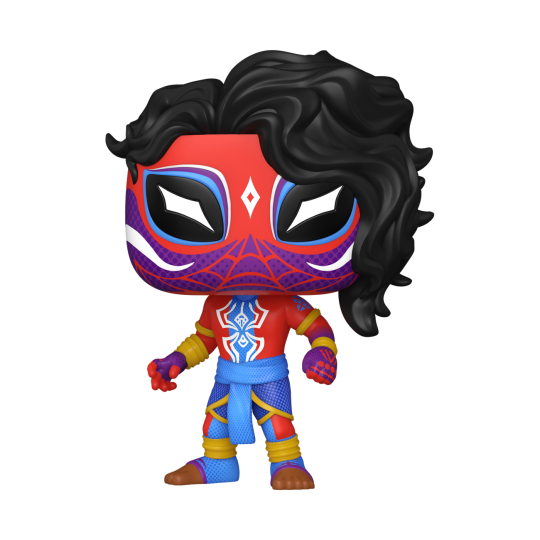
This decorative marking, bindi/pottu/tilaku, might actually be the most recognizable aspect of Indian culture across the world.
If you scroll back to all the previous images I provided, you can see some variation of this in all of them, either drawn on, or as an ornament. While there are some cultural differences in how they're worn, like women in southern India wearing them in all stage of life while their northern counterparts wear them only after marriage(I could be wrong about this, as I've seen children wearing them often, and things could've changed in modern times so please do correct me if I'm wrong), its one of the most common motifs you'll see across the country.
It can be a simple, round mark.
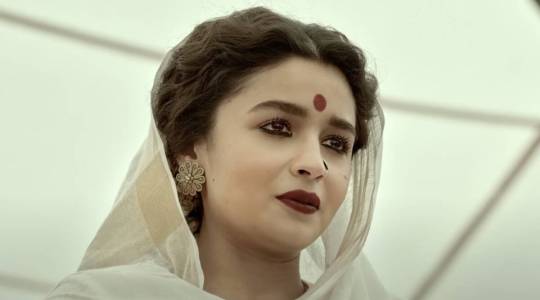
It can be ornamented.

It can be a different shape altogether.
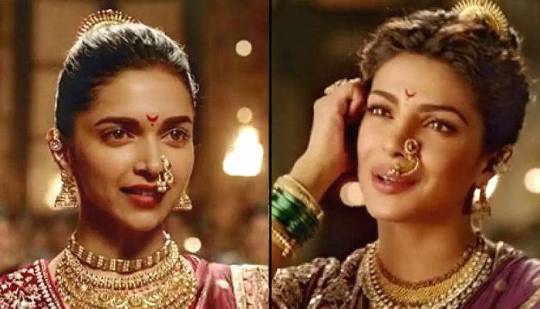
(From the musical sequence 'Pinga' in the Hindi film Bajirao Mastani)
A different colour.
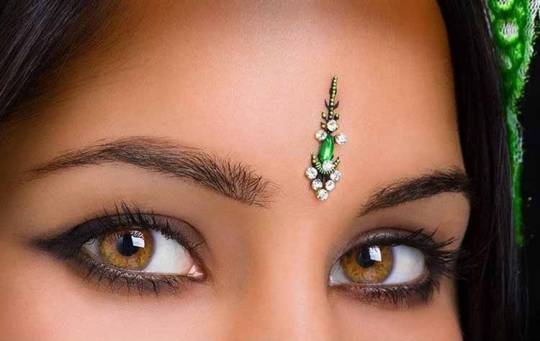
You get the idea.
Men can wear it as well. though styles and decoration maybe different.
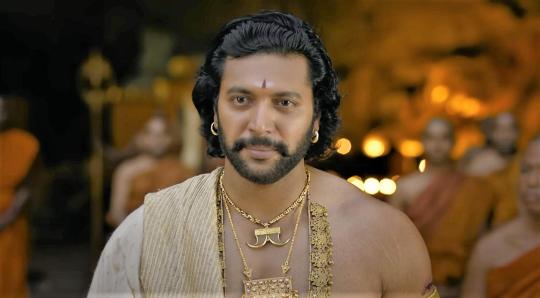
(From the Tamizh film Ponniyin Selvan 1)
A more modern version.
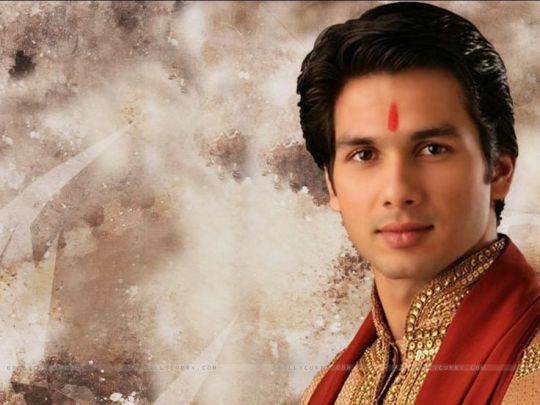
Geography wise, the bindi/pottu/tilak is predominantly seen in India, but its also found in other countries of the Indian subcontinent and neighbouring nations, as well as South-East Asia(as they were both part of the ancient Indosphere and had a past of Hindu Kingdoms. See: Srivijaya(Sriwijaya) empire, Indonesia).
Similar forehead markings were even common in China in the past. Those who have seen wuxia and xianxia dramas and movies definitely have seen them before and know what I'm talking about. (Huadian 花鈿)
Religion wise, its predominantly a Hindu motif, but its also part of Buddhist, Jain, Sikh, as well as several other indigenous religions.
{I've actually seen several Indian Christians and Muslims wear it as well, because its their culture, even if its not their religion.}
EDIT: Gaaaaah! I forgot to include this even though I'd intended to from the beginning.
This is not about the mask but some of the prototype designs for Pavitr so I thought I'll just talk about them a bit here.
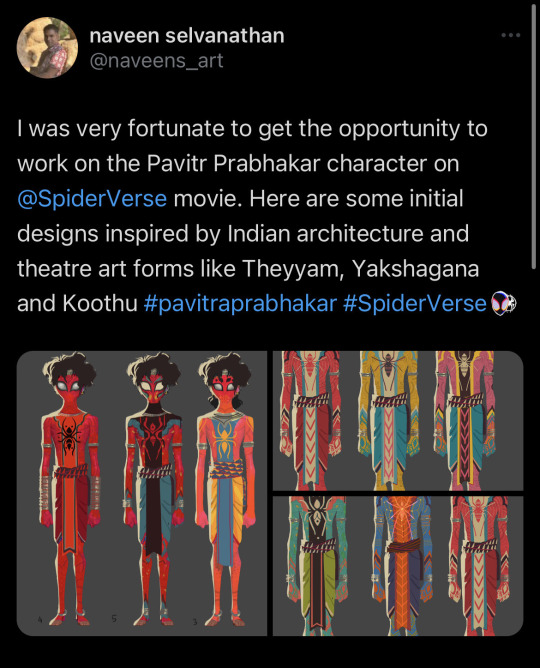
Again I can't believe all the effort that went into making this movie. Just look at those designs. Absolutely stellar and inspired. The colour palette itself is amazing.
Honestly everyone else just has no excuse anymore.
[I'll focus on the theatre aspect like I've been doing and talk about the architecture bit sometime else.]
This one is obviously the Theyyam inspired one.

(Look at the eyes of 4 and 3, you can see they're inspired by the silver eye-mask I mentioned before. Also the headband is silver and looks similar to the bands securing a theyyam's headgear in place.)
A lot more Theyyam elements than what made it to the final cut. Especially the jewellery and the sharp-eyed among you must've already noticed the similarity between the necklaces of the design and the necklaces of the theyyams whose images I provided. The bangles and the anklets are also very distinctively Theyyam and they're called Katakam and Chutakam respectively but the final design seems to have made the bangles gold and more bracelet-like, and the anklets more like ankle-cuffs.
(I so badly wish the necklace stayed in but yeah that could've hindered movement.)
Now lets come to the Yakshagana inspired one.

(Notice how the shape of the eyes have changed? And the colour palette took a turn? A lot more gold coming in.)
Yakshagana is a form of traditional theatre originating in modern day Karnataka state of India, and currently practiced in both Karnataka and Kerala. It is primarily an art form from the coastal Karnataka region and the neighbouring Kasargod district of Kerala.
Below is a link to more information on Yakshagana so you can take a look at the costuming and see the influences in the above prototype more clearly.
(I'm not gonna go into detail about all the design choices in the Yakshagana prototype, maybe in another post.)
Now lets come to the final prototype.
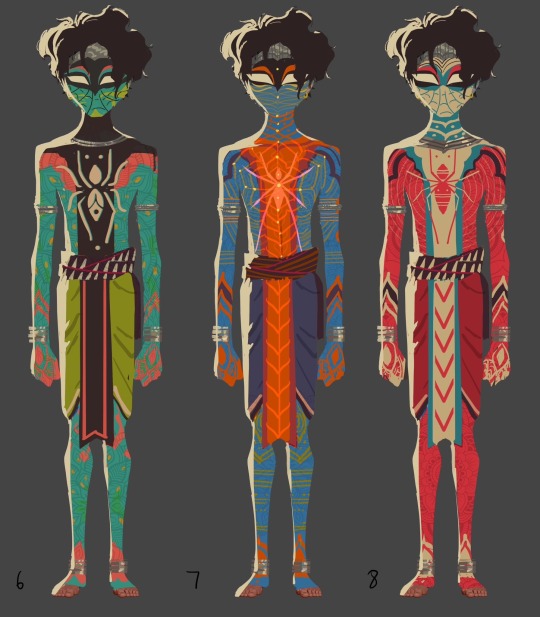
(Again the colour palette has shifted, a lot more greens and blues. I do believe that 8 is koothu and not Yakshagana even though it was included in the image above. I say that because of all the white in the design which is very distinctive of a kind of koothu as far as I'm aware.)
I actually already mentioned koothu once before in this post when I was talking about Koodiyattam in the very beginning. So lets go back to it.
Koothu is a folk theatre art that originated in early Tamizh country(Tamizhakam), and broadly speaking, its of two types, Terrukuttu, and Kattaikkuttu. It reached its peak in the golden age of Tamizh culture, the Sangam era and it mainly depicts scene from the epics. Currently types of Koothu are practiced in modern day Tamil Nadu and Kerala(Kerala was once part of ancient Tamizhakam).
Below is a link that will give you more info and an image of the costume with makeup similar to 6.
And this one is a link to a particular kind of koothu in Kerala known as Chakyar Koothu cos all the white on the make of prototype version 8 reminded me of it. (Also Chakyar Koothu is a form of social satire and criticism, it was basically ancient Stand-up comedy and the Chakyar is supposed to be really witty, which fits Spiderman to a T I gotta say.)
Again I'm not gonna go into further details and nuances of the design as this is a prototype design, maybe some other time. But I have to say that this colour palette does make Pavitr a lot more spideresque or evoke a more primal spider energy cos how it connects the viewer to jungle like and more animalistic environments more than the other designs.
And that's it for the mask and the prototypes everybody! Yay!
Holy shit that was long!
I'm gonna stop here for now cos this is already way too much. Can't believe I thought I'd be able to look through the entirety of Pavitr's design in one post. What was I on?
Seriously what kind of drug?
Anyway I'll be making a part 2 for this, looking through Pavitr's clothes and and movements and all. I say Part 2 but considering what happened with the mask I'm pretty sure it might go up to Part 3 or 4. Here's to hoping I learn some moderation by then lol.
(All the images are from google images and I have taken and have credit for exactly none of them. The verbiage is mine completely though.)
#Pavitr Prabhakar#Spiderman India#Indian spiderman#desi spiderman#spiderman atsv#character design#desi design#the desi-gn get it? I'll show myself out#across the spiderverse#spiderman: Into the Spiderverse#Spiderman: Across the Spiderverse#sony spiderverse#atsv#so much love and effort went into this movie and it shows#it was absolutely magnificent#character design inspiration#Indian culture#traditional theatre#traditional artforms#Theyyam#Koodiyattam#Kathakali#Yakshagana#Koothu#Tamil culture#Tamizh culture#Malayali culture#Kannada culture#tulu culture#tuluva culture
82 notes
·
View notes
Text
Refresh your wardrobe with Heaven clothing store in Trivandrum
Introduction:
As we search in the ever-changing landscape of fashion,it is easy to get lost in the sea of trends and fast-fashion. But at Heaven Clothing Store in Trivandrum,we believe that style and sustainability go hand in hand. Our mission is to provide high-quality,fashionable clothing that not only makes you look and feel great but also supports a more environmentally friendly future. As we support more sustainable future fashion clothing
Indian fashion culture
Indian fashion culture is a vibrant tapestry woven with threads of tradition, innovation, and storytelling. At the heart of Indian fashion lies the timeless art of handloom weaving. Across the length and breadth of the country, skilled artisans ply their craft, creating fabrics that are as rich in history as they are in texture. From the luxurious Banarasi silks to the earthy elegance of Khadi, each handloom creation is a testament to India's artisanal heritage, passed down through generations with love and reverence. We cannot talk about Indian fashion without mentioning legendary sarees. The sari, a beautiful piece of clothing, represents grace, tradition, and feminine charm. It comes in many different styles across India, showing the country's diverse culture. Despite changing fashion trends, the sari remains a timeless symbol.
So Heaven Clothing and the saree boutique in Trivandrum know the importance of sarees. We are passionate about sarees and dedicated to providing our customers with the finest handcrafted designs that celebrate India’s rich textile heritage. We provide a huge collection of traditional and special sarees for our customers.
Indian ethnic wear includes lots of different kinds of clothes that people wear for special occasions or just every day. For example, there's the saree, which is a long piece of cloth that women drape around themselves in different styles. Then there's the salwar kameez, which is like a long shirt paired with loose pants and a scarf. It's comfy and can be fancy too. For big celebrations like weddings, women often wear lehenga cholis, which are fancy skirts with matching tops and scarves. Men have their own traditional outfits too, like the sherwani, which is a fancy coat worn with pants, or the kurta pyjama, which is a long shirt with loose pants. These clothes come in lots of different styles and colors, showing off India's rich cultural diversity.
Indian fashion culture extends far beyond the glitz and glamor of the runway, permeating every aspect of daily life. From the ornate bridal ensembles worn during lavish weddings to the everyday attire of bustling markets and bazaars, fashion is an integral part of Indian society. It's not just about looking good; it's about self-expression, cultural identity, and storytelling through attire. In this way, Indian fashion becomes a language of its own, speaking volumes about tradition, status, and personal style.
In Kerala, people wear a mix of old and new styles. Women often wear traditional Kerala sarees, and men wear Mundus, especially for special events. They look very classy, especially when paired with fancy gold jewelry. But nowadays, Western clothes are also getting popular, especially among young people. Even with these new trends, people still love and value Kerala's cultural traditions. You can see this in the colorful and stylish clothes they wear, which show off both old and new influences. Kerala's fashion is like a mirror, showing its rich history and changing identity.
Heaven clothing store really looking forward to Kerala fashion culture; it becomes heaven as the leading Trivandrum dress shop. We set up a special collection of a mix of traditional wear and western clothing for you. However, as fashion changes, Heaven's clothing also changes.
Traditional wears of India.
India's traditional attire is a vibrant tapestry reflecting the country's diverse cultures, regions, and historical influences. The sari stands as an iconic symbol of Indian femininity, with its graceful draping styles and intricate designs varying from region to region. Meanwhile, the salwar kameez, with its combination of a long tunic, loose trousers, and scarf, holds sway in North India, offering both elegance and comfort. For festive occasions and weddings, the lehenga choli steals the spotlight, blending ornate skirts, fitted blouses, and flowing dupattas into dazzling ensembles, particularly popular in the northern states.
In the world of men's clothing, different outfits have their own special place. The sherwani is the go-to choice for fancy events, with its fancy designs and classic look. On the other hand, the kurta pajama is more relaxed but still stylish, making it good for everyday wear or less formal gatherings. In the southern parts of India, the dhoti is popular. It's simple and traditional, worn by wrapping it around the waist and legs gracefully. In Gujarat and Rajasthan, during celebrations, you'll often see women wearing the colorful ghagra choli. It has vibrant skirts, fancy tops, and flowing scarves, reflecting the festive mood.
India's clothing also varies by region. In Kerala, men wear the mundu. In Kashmir, the pheran is common. And across India, the bandhgala, or Nehru jacket, is loved for its classy look. Each outfit has a story behind it, reflecting the culture and history of its region. Together, they create a rich tapestry of colors, fabrics, and traditions that represent India's diverse people.
Heaven Clothing Store in Trivandrum has special collections of traditional wear, not just Kerala's traditional wear. All over India, traditional wear is in our collection. We also have special wedding collections for the bride and groom. You can select any Indian traditional wear from our store.
Office Outfits.
An office outfit refers to the clothes people wear to work in a professional setting. It typically includes formal or semi-formal attire such as dress shirts, trousers or skirts, blouses, suits, dresses, and appropriate footwear like dress shoes. The specific dress code may vary depending on the workplace culture and industry norms. The aim of an office outfit is to look polished, presentable, and suitable for the work environment while also reflecting personal style within professional boundaries. It's all about looking professional and appropriate for your job. For guys, this usually means shirts, pants, and maybe a tie or a suit. For ladies, it could be a blouse and skirt or pants, a dress, or even a professional-looking top with trousers. The key is to choose clothes that are neat, clean, and not too casual. You want to make a good impression and feel confident while you work.
Women's fashion is currently experiencing a dynamic shift towards sustainability, with a notable emphasis on eco-friendly materials and ethical production practices. This trend reflects a growing awareness of environmental issues and a desire for clothing choices that align with values of responsibility and stewardship. Additionally, the athleisure trend remains popular, seamlessly integrating athletic wear into everyday outfits for a comfortable yet stylish look. Oversized silhouettes are also making a statement, offering a relaxed and effortless aesthetic that prioritizes comfort without sacrificing style. Another emerging trend is romanticized cottagecore fashion, characterized by soft, feminine silhouettes, floral prints, and vintage-inspired pieces that evoke a sense of nostalgia and simplicity. Furthermore, there's a noticeable shift towards gender-neutral fashion, with styles and silhouettes designed to be inclusive and accommodating, shaped by factors such as social media, cultural influences, and sustainability concerns, providing women with a diverse range of options to express their individuality and style preferences. to individuals of all genders.
Men's fashion is currently embracing a blend of classic styles with modern twists, catering to a diverse range of tastes and preferences. Sustainable fashion is gaining traction, with an increasing number of brands offering eco-friendly materials and ethical production practices. Athleisure continues to be a prominent trend, seamlessly blending athletic wear with casual and formal attire for a versatile and comfortable look. Tailoring is also making a comeback, with a focus on well-fitted suits, jackets, and trousers that exude sophistication and style. Additionally, streetwear-inspired looks remain popular, characterized by bold graphics, oversized silhouettes, and urban influences. Men's fashion is evolving to embrace individuality and self-expression, with a focus on quality craftsmanship, versatility, and sustainability.
The "dark side" of fashion refers to the less visible but deeply concerning aspects of the industry, characterized by unethical practices and environmental harm. One prominent issue is the exploitation of workers, particularly in developing countries, where labor regulations are often lax. Garment workers endure long hours, low wages, and unsafe working conditions in factories, contributing to social injustices and human rights violations. Moreover, the fashion industry's rapid production and consumption cycle, known as fast fashion, fuels overproduction, excessive waste, and environmental degradation. Processes like dyeing fabrics and chemical treatments contribute to pollution and resource depletion, further exacerbating the industry's environmental footprint. Additionally, a lack of transparency in supply chains makes it challenging to trace the origins of materials and ensure ethical and sustainable practices throughout production. Addressing these issues requires collective action from industry stakeholders, consumers, and policymakers to promote ethical labor standards, environmental sustainability, and transparency in the fashion supply chain.
.
Solution for this is sustainable fashion Sustainable fashion refers to clothing, accessories, and footwear that are designed, produced, and used in ways that are environmentally friendly and socially responsible. This involves considering the environmental impact of materials and production processes, as well as promoting fair labor practices throughout the supply chain. Sustainable fashion encompasses various practices, including using organic or recycled materials, reducing waste through efficient design and production methods, and supporting ethical labor standards. Additionally, sustainable fashion encourages consumers to make mindful purchasing decisions, such as investing in high-quality, long-lasting pieces and supporting brands that prioritize sustainability. By promoting environmental stewardship and social equity, sustainable fashion aims to create a more ethical and resilient fashion industry.
3 notes
·
View notes
Text
15 Traditional Indian Bridal Wear from Different Regions

India is a land of diverse cultures, languages, and traditions, showcases a diverse array of bridal attire, each intricately tied to its respective region. Weddings in India are extravagant , and the bridal wear holds significant importance in defining the overall aesthetic. The cultural tapestry of the nation finds expression in the distinct styles, fabrics, and embroidery techniques that vary from state to state.
From the luxurious Banarasi silk saris of the North to the graceful Kasavu sarees of Kerala, and from the lively Phulkari of Punjab to the majestic Zardozi lehengas of Uttar Pradesh, each bridal ensemble narrates its unique tale. As India progresses, these customary bridal dresses persist as enduring symbols of the nation's vibrant cultural legacy.
Bridal Wear From Different Parts of India
Let's explore 15 types of traditional Indian wedding attire from different regions, showcasing their significance, craftsmanship, unique attributes, materials, embroidered designs, and other captivating elements. We'll also touch on what the bride's family can wear during the ceremony.
Banarasi Silk Saree (Varanasi):
The Banarasi Silk Saree, the origins of Banarasi saris can be traced to the Mughal era around the 14th century , symbolizes bridal luxury, elegance, and enduring tradition. These saris hold immense cultural significance and are favored by brides seeking a regal presence on their wedding day. Crafted with meticulous detail, they boast intricate weaving of gold and silver threads, a skill passed down through generations.

Featuring elaborate brocade work with resplendent Zari, inspired by the majestic Mughal era, they exude timeless allure. Made from pure silk renowned for its luxurious texture and sheen, and adorned with exquisite gold and silver threads, these saris epitomize opulence.

Their elaborate embroidery, incorporating Zari and brocade, presents upon brides a royal grandeur, ensuring they feel like queens on their special day. Thus, Banarasi silk sarees remain a cherished and timeless choice for bridal attire.
Kanjeevaram Silk Saree(South India) :
The Kanjeevaram Silk Saree, got its name from the temple city of Kanchipuram in Tamil Nadu, India. Kanjivaram silk sarees have their origins in Hindu mythology. The Kanchi Silk Weaver is believed to be a descendant of Sage Markanda, the Gods' Master Weaver. Kanjivaram weave has a history of 400 years and it is said that the two large weaving communities Devangas and Saligars from Andhra Pradesh relocated to Kanchipuram to weave Kanjivaram sarees.

What sets the Kanjeevaram silk saree apart are its distinctive features: rich color combinations, intricate temple borders, and traditional checks patterns. These saris' vibrant hues and contrasting shades create a stunning look for brides, while the temple borders, inspired by South Indian temples, add a divine touch. The check pattern enhances their timeless elegance.

Image Courtesy: Wedding Wire
Characterized by heavy golden Zari work, the embroidery style of these saris exudes regal opulence. This seamless blend of luxurious silk, vibrant colors, and intricate Zari work makes the Kanjeevaram silk sari a quintessential representation of South Indian culture, offering brides a timeless choice to radiate elegance and tradition on their special day.
Mohi Fashion
Website: www.mohifashion.com

Mohi is a curated multi-designer online marketplace offering lehengas, Indian sarees, designer wear, lehenga for engagement, lehenga for reception, Ghagra choli for women and men's groom wear. They source their products from Surat, Jaipur, Kolkata, Tamil Nadu, Chandni Chowk, Lucknow, Assam, Pakistani wear and so on, providing a focus on reflecting the diversity of South Asian fashion. Mohi Fashion provides a 10% discount on all MRPs year-round and exclusive offers, along with video consultations for brides and customizable outfits in all sizes.
Lehenga Choli (Rajasthan, North India) :
The Lehenga Choli, a traditional bridal attire originating from Rajasthan in North India, is a masterpiece that accentuates the bride's beauty, evoking a princess-like feel on her special day. Lehenga became most popular among women, mainly in North India in the 10th century. Lehengas were the attire of Rajput's but it was Mughals who evolved the lehengas into Indian fashion.

Embellished with intricate Gota patti work, it exudes grandeur, same as royal adornments, elevating the bride's stature. Crafted from luxurious silk or georgette, it offers both comfort and graceful draping, enhancing the bride's elegance. The enchantment lies in the embroidery – mirror work, Zari, and sequins – reflecting the bride's radiance, adding sophistication, and lending sparkle.

Beyond mere attire, the Bridal Lehenga Choli embodies a celebration of the bride's beauty and new journey, enhancing her charm and honoring Rajasthan's rich heritage. It transforms dreams into reality, rendering the bride as the epitome of beauty and royalty on her special day.
Paithani Sari (Maharashtra, West India) :
The Paithani Sari originated in Paithan, in the 2nd century B.C. Satavahana Empire nestled a small town on the banks of River Godavari, named ‘Pratishthana’. Pratishthana was the capital of the Satavahana Empire under the rule of Shalivahana. Pratishthana hosted a trade center and was renowned for being an international hub for the sale of Silk and Zari. The old city of Pratishthana was named Paithan later.

Image Courtesy: Vogue
Crafted from pure silk with gold and silver threads, it offers luxurious comfort and elegance. The shimmering threads create a magical aura, enveloping the bride in a captivating glow. Embroidered with lustrous gold Zari, the Paithani Sari captures the bride's innate radiance, serving as a living tribute to Marathi artistry.

More than just attire, the Paithani Sari bridges history and tradition, allowing the bride to embody tradition and grace in a remarkable way on her special day.
Mekhela Chador (Assam, Northeast India) :
The Mekhela Chador, originating from Assam in Northeast India, enhances the bride's beauty while reflecting the simplicity and elegance of Assamese culture. This attire epitomizes tradition and grace, distinguished by handwoven motifs resonating with Assamese heritage. Adorned with delicate designs featuring peacocks, flowers, and traditional patterns, it embodies Assam's natural beauty and cultural richness.

Image Courtesy: Pinterest
Crafted from fabrics like Muga silk, Eri silk, or cotton, it drapes gracefully around the bride, offering a unique texture and natural sheen that accentuates her elegance. The minimalistic yet intricate embroidery adds a touch of artistry to the attire.

Image Courtesy: Pinterest
Symbolizing Assamese culture and the assam mekhela saree bride's connection to it, the Mekhela Chador elevates her beauty by embracing simplicity and heritage, allowing her to exude a unique charm that speaks of tradition and grace on her special day.
6. Phulkari (Punjab, North India):

Phulkari, originating from Punjab in North India, is a bridal masterpiece reflecting the lively spirit of the region. This traditional attire features hand-embroidered floral motifs that uniquely enhance the Punjabi bride's appearance. Known for its vibrant colors and intricate floral patterns, Phulkari symbolizes the exuberance and rich cultural heritage of Punjab.

Image Courtesy: Pinterest
Crafted from lightweight fabrics like georgette or chiffon, Phulkari drapes around the bride with delicate grace, enhancing her beauty. Its dense threadwork in vibrant colors infuses the Punjabi bride's ensemble with vivacious energy, embodying Punjab's joyful and colorful culture. Worn not just as an outfit, but as a celebration of roots, Phulkari elevates the bride's beauty while honoring Punjab's spirit on her special day.
Kasavu Sari (Kerala, South India) :

Image Courtesy: Shaadi Wish
The Kasavu Sari, originating from Kerala in South India, enhances the bride's beauty with its simplicity and grace. This bridal attire, characterized by plain white fabric and a golden border, symbolizes the cultural richness and elegance of Kerala. Its hallmark is the traditional gold border, often adorned with cream or off-white fabric, imparting the bride with a delicate and airy aura.

Kasavu Kerala Saree Crafted from comfortable materials like cotton or silk, this sari drapes the bride with gentle, natural beauty. Featuring minimalist embroidery, the main focus remains on the plain fabric and the golden border, evoking traditional charm and allowing the bride to radiate in understated elegance on her special day.
8. Chanderi Silk Sari (Madhya Pradesh, Central India) :

The Chanderi Silk Sari, originating from Madhya Pradesh in Central India, enhances the bride's beauty with the region's unique charm. Featuring delicate handwoven motifs such as graceful peacocks and intricate florals, this sari adds elegance to the bride's look. Its sheer texture and pastel colors, complemented by shimmering silver or gold Zari threads, exude refined grace.

Chanderi sarees are Crafted from comfortable materials like silk, cotton, or blends, it drapes the bride with sophistication. The embroidery style highlights fine motifs in Zari and buta work, showcasing the skill of local artisans and transforming the bride into a vision of timeless beauty on her special day.
9. Pochampally Saree (Telangana, South India) :

The Pochampally Saree, originating from Telangana in South India, is a bridal masterpiece that enhances the bride's beauty while honoring the region's rich weaving heritage. These Pochampally Sarees are crafted using the intricate Ikat dyeing technique, resulting in stunning geometric designs that enrich the bride's appearance with cultural significance.

Handmade from premium materials like silk or cotton, they drape the bride with graceful allure, highlighting the mesmerizing dyeing technique that encapsulates the spirit of Telangana. This unique symbol of heritage turns the bride into a living work of art and tradition on her special day.
10. Bandhani Lehenga (Gujarat, Western India) :

The Bandhani Lehenga, originating from Gujarat in Western India, enhances the bride's beauty while reflecting the vibrant Gujarati culture. Crafted using the tie-dye technique, it features intricate and colorful patterns that add vibrancy to the bride's ensemble. Made from materials like georgette or silk, this lehenga drapes the bride with an elegant flow.

The minimalist embroidery style highlights the captivating Bandhani patterns, paying homage to the local artistic tradition and turning the bride into a canvas of tradition and beauty on her special day.
11. Gota Patti Lehenga (Rajasthan, North India) :

The Gota Patti Lehenga, originating from Rajasthan in North India, is a bridal masterpiece that exudes Rajasthani grandeur, enhancing the bride's beauty with meticulous gold or silver gota work. This attire boasts elaborate embellishments, including mirror work, creating a resplendent ensemble.

Gota Patti Lehengas are Crafted from luxurious fabrics like silk, georgette, or chiffon, it drapes the bride in regal splendor. The intricate embroidery style features stunning gota work with mirror accents, transforming the bride into a vision of opulence and magnificence on her special day.
Kasuti Saree (Karnataka, South India) :
The Kasuti Sarees, originating from Karnataka in South India, is a masterpiece that enhances a bride's beauty with artistic splendor, representing the rich cultural heritage and craftsmanship of the region. Adorned with hand-embroidered geometric patterns, these kasuti sarees showcase Karnataka's unique artistry and are celebrated for their rich black and red color combinations.

Crafted from fine materials like cotton or silk, they drape the bride with comfort and elegance. The striking embroidery style features intricate geometric designs in contrasting colors, celebrating art and culture, and making the bride's beauty stand out on her special day.
13. Zardozi Bridal Lehenga (Uttar Pradesh, North India) :

The Zardozi bridal lehenga, originating from Uttar Pradesh in North India, epitomizes Mughal-era extravagance and opulence, paying homage to the region's rich cultural heritage and historical grandeur. Intricate gold and silver embroidery adorn the lehenga with meticulous precision, featuring heavy embellishments often adorned with precious stones for a regal touch.

Crafted from sumptuous fabrics like velvet, silk, or brocade, it drapes the bride with a lavish aura, evoking a sense of royalty. Elaborate zardozi work and beadwork further enhance the grandeur of the lehenga, creating a bridal outfit that celebrates tradition while elevating the bride's beauty to epitomize timeless elegance and sophistication on her special day.
Zardozi bridal lehenga is Crafted from luxurious silk or brocade, the fabric drapes the bride with finesse, evoking a princess-like feel. The heavy Zari and sequin work add shimmer and magic, ensuring the bride exudes enchanting allure on her special day.
Gharara (Hyderabad, South India) :
The Gharara ensemble, originating from Hyderabad in South India, exudes Nizami elegance, enveloping the bride in grace. Adorned with intricate hand embroidery featuring Zari and sequins, it adds opulence and regal charm to the bride's look. This ensemble's specialty lies in its richly embroidered kurti, flared pants, and accompanying dupatta, creating a complete look that elevates the bride's beauty with royal grandeur.

Pheran and Kalidar (Jammu & Kashmir, North India) :
The Pheran and Kalidar ensemble, originating from Jammu & Kashmir in North India, embody a royal masterpiece, adding a touch of regal charm to the bride's special day. Traditionally donned by brides, these Pheran dresses carry profound significance, representing the rich heritage of the region. The Pheran dress is a long, loose outer garment, and the Kalidar, a set of flared trousers paired with a fitted tunic, feature exquisite hand embroidery and intricate Kashmiri motifs, showcasing local craftsmen's skill and artistry.

Pheran Dresses are Woven from luxurious materials like sumptuous velvet or silk, they present an elegant and regal look upon the wearer, creating a unique ensemble that exudes regal charm and cultural significance.
The diversity of Indian bridal wear reflects the kaleidoscope of cultures and traditions across the nation. Each region offers a unique glimpse into the rich heritage, craftsmanship, and artistry that goes into the creation of these stunning ensembles.
3 notes
·
View notes
Text
Alluring Tourist Places & Wildlife Sanctuary in Kerala you should know before going on Kerala Trip
Do you want to go on a trip to Kerala? If Yes, you should also know about Tourist Places in Kerala, Kerala's history, traditional dress, economy, geography, and the fascinating wildlife sanctuary in Kerala. These are the things you must know before going on the Kerala tour. To learn more, visit our blog.
#tourist places in kerala#kerala traditional dress#kerala festival#kerala history#wildlife sanctuary in kerala#famous festival of kerala#kerala economy#kerala wildlife#kerala geography
1 note
·
View note
Text

𝐒𝐭𝐲𝐥𝐢𝐧𝐠 𝐖𝐨𝐦𝐞𝐧'𝐬 𝐎𝐧𝐚𝐦 𝐎𝐮𝐭𝐟𝐢𝐭𝐬: 𝐄𝐦𝐛𝐫𝐚𝐜𝐞 𝐓𝐫𝐚𝐝𝐢𝐭𝐢𝐨𝐧 𝐰𝐢𝐭𝐡 𝐚 𝐌𝐨𝐝𝐞𝐫𝐧 𝐓𝐰𝐢𝐬𝐭
Discover the latest Onam dress collection for women that combines traditional elegance with modern fashion. Our curated article showcases stunning ensembles that capture the essence of the festival.
#Onam Fashion#Traditional Elegance#Modern Twist#Onam Dress Collection#Festival Fashion#Fashion Design#Fashion Institute#Stylish Traditional Dresses#Festival Outfits#WIFD#Kerala
0 notes
Text
Kerala set saree
Haradhi is widely regarded as the best Kerala saree brand in Palakkad, celebrated for its exquisite collection of Kerala pattu sarees. Known for their rich texture and traditional craftsmanship, these sarees are a staple in every woman's wardrobe, especially for festive and special occasions. Haradhi's commitment to quality and authenticity ensures that each saree is woven with precision and care, capturing the essence of Kerala's cultural heritage.
For those who love the convenience of online shopping, Haradhi gives a hassle-free Kerala saree online shopping experience. Their user-friendly website showcases a diverse range of sarees, allowing customers to browse and select their favorite designs from the comfort of their homes. With detailed product descriptions and high-quality images, you can be assured of making an informed choice.
Whether you're looking for a classic pattu saree or a contemporary design, Haradhi has something to suit every taste. Explore their collection today and embrace the timeless elegance of Kerala sarees.
0 notes
Text
Embrace Kerala Traditional Dress for Kids – A Collection for NRI Malayalees
As the joyous festival of Vishu approaches, it’s time to celebrate tradition and culture with a touch of elegance and charm. For NRIs in GCC countries who wish to shower their loved ones back home in Kerala with affection and traditional attire, Nakshatra Kids presents an exquisite collection of Vishu special dresses for kids

#Kerala Traditional dress for kids#Pattu pavadai for kids#Vishu Special dress#Eid Special Dress#Baby Kids Dress#vishu special dress for kids#vishu special dress for baby girls
0 notes
Text
KERALA : GOD'S OWN COUNTRY
Famous as ‘God’s Own Country,’ Kerala is a southwest corner of India, which has an area of 38,863 sq km and a population of about 3.48 crores. Kerala is known to be the best state in India, and without a doubt, it is said to be paradise on the land of India. It is full of coconuts and elephants, which contributes to the rich biodiversity and cultural heritage of the state. Moreover, captivating beauty, lagoon, and backwaters of Kerala attract around ten million tourists every year.
KERALA CULTURE
The culture of Kerala is indeed an integral part of Indian heritage. Like the Indian subcontinent, the culture of Kerala also has an archaic history that claims to be significant in itself. Kerala also has a holistic and cosmopolitan lifestyle in which many people and castes have contributed significantly. The spirit of inclusive and diversified tolerance and generosity of attitude among the people of Kerala is still alive to develop the leadership quality. The history of Kerala represents a romantic and fascinating story of a unique process of cultural and social synthesis. Kerala has shown the best of its talent in every field, responding to every challenge and, at the same time combining old traditions and new values with human facts.
Kerala has a total of 14 districts, each of which is famous for its unique destination and temptation.
Idukki
Wayanad
Kottayam
Malappuram
Kozhikode
Kasaragod
Alappuzha
Kannur
Ernakulam
Kannur
Pathanamthitta
Thrissur
Kollam
Palakkad
Thiruvananthapuram
Traditional Attire of Kerala
The traditional dress in Kerala is called Mundu and Neriyatu, which is for both men and women. Women of Kerala traditionally wear sarees. Mundu is very popular in the state and is worn by men. It is an elegant dress, often used for ceremonial purposes.
The Mundu Nerihathu of women has an upper shawl. White-colored clothes have been given the most importance in the state. Presently different colored Mundu and Nerihathu are available in the market.
CLIMATE
Kerala is situated at an interval of only 8 degrees from the equator, due to which the weather of Kerala is warm. The main feature of the climate of Kerala state is “the cold downpour and heavy rainfall.” The main Rainy season begins with the western monsoon. The second rainy season comes with the northwest monsoon. Kerala rains for about 120 to 140 days every year. Heavy rains in Kerala also cause floods, prompting the considerable loss of lives and wealth.
KERALA FOOD
Kerala cuisine is a combination of vegetables, meats, and seafood with a wide variety of spices. Spices such as black pepper, cardamom, cloves, ginger, and chili are most commonly used in rice, coconut, seafood, and non-vegetarian dishes. Food in Kerala has its share of vegetarian dishes, including various tubular and root-based vegetables, as well as the use of beet-root, ginger, garlic, and onions along with animal milk.
Therefore, the food here is a balanced mix of non-vegetarian and vegetarian preparations. Traditionally, food is served on a banana leaf in Kerala, and almost every dish prepared in Kerala has coconut and spices to taste the local cuisine.
2 notes
·
View notes
Text
Kerala weddings are renowned for their rich traditions, vibrant colors, and timeless elegance. For both the bride and groom, choosing the right attire for the reception is an important part of embracing the cultural heritage while making a style statement. This guide explores popular choices for a Kerala wedding reception dress for both bride and groom, blending modern trends with the essence of South Indian tradition.
0 notes